
Spanish Adventurers
| View previous topic :: View next topic |
| Author |
Message |
Salty Dog

Sailing Master 
Posts: 10060 



191991 Gold -

|
 Posted: Sun Oct 01, 2017 3:27 pm Post subject: Spanish Adventurers Posted: Sun Oct 01, 2017 3:27 pm Post subject: Spanish Adventurers |
 |
|
Spanish Adventurers
Pirates and Corsairs at Home and in the New World
By Cindy Vallar
Whether pirate or corsario (privateer), Spanish adventurers prowled the seas even before Christopher Columbus claimed lands in the New World for King Ferdinand and Queen Isabella. Some held commissions – either letters of patent or letters of marque – while others raided without these legal documents. At times they did both, just like their counterparts from other nations, such as Sir Francis Drake or Sir Henry Morgan. Another commonality was that unless they made a significant contribution or detriment, many never entered the historical record. For example, Lupo de Bertagno’s fusta sailed the Aegean Sea between 1452 and 1460. His plunder came from Venetian cities and their vessels. A Catalan corsair, he eventually came to rule Monemvasia in southern Greece, but those living there soon sought someone else to protect them from the intrusion of the Ottoman Empire.
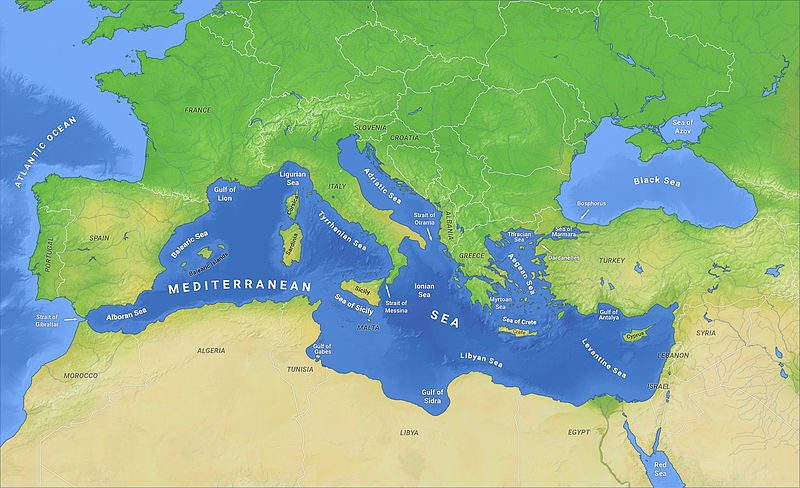
De Bertagno may have been descended from the original Catalan Company, a group of mercenaries hired to fight the Ottoman Turks in the early fourteenth century. After the murder of their leader in 1305, they forsook the Byzantine emperor who had hired them and plundered his subjects as they moved west and south. Some eventually turned to piracy and occasionally allied themselves with corsairs from Asia Minor to attack ships from France, Italy, and Venice.
Diego de Orduña, on the other hand, was a pirate. In 1492, his caravel was taken by Christian warships. His captors, members of the Knights of Rhodes, executed him and enslaved his men on galleys. |
|
| Back to top |
|
 |
Salty Dog

Sailing Master 
Posts: 10060 



191991 Gold -

|
 Posted: Sun Oct 01, 2017 3:30 pm Post subject: Posted: Sun Oct 01, 2017 3:30 pm Post subject: |
 |
|
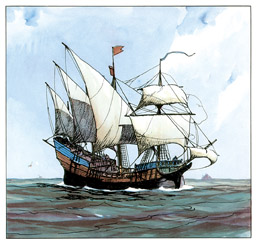 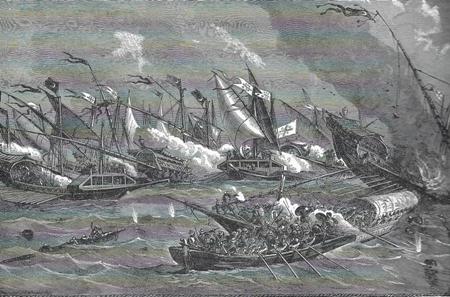
Top: 16th-century Caravel (Source: Dover Clip Art)
Bottom: Mediterannean Sea battle between Crusaders and Islamic forces (Source: Nautical Illustrations)
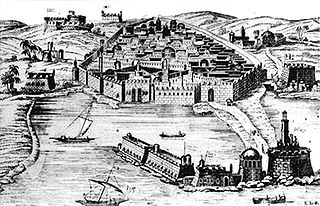
Two sixteenth-century corsairs were Guy Borel Valdiviessa E Maldanato and Juan Canete. Valdiviessa cruised the Mediterranean in 1504. His claim to fame was that he captured an Ottoman sultan’s son, whom he took to Rhodes to sell into slavery. The captive managed to escape, only to fall into the sea and drown. Juan Canete was more successful. He sailed from Majorca around the middle of the sixteenth century, and his favorite prey lived on the North African coast. Once he kidnapped those who slept outside the walls of Algiers. Under cover of darkness in 1550, he attempted to torch ships belonging to Algerine corsairs; instead, they captured him. Nine years passed before he was executed.
After Spain staked its claim on the New World, Spanish ships ventured back and forth without much hindrance from human predators. Treasure rumors spiraled throughout Europe, but Spain’s enemies lacked proof until a French corsair named Jean Fleury seized two caravels laden with Aztec treasure near the Azores in 1526.1 The following year in October, Fleury found himself in a bloody fight with a well-known Spanish privateer, Martín Pérez de Irizar. Although thirty-seven Spaniards died and another fifty were wounded, Pérez captured 150 men, including Fleury. He was taken to Seville, where he was tortured until he confessed to piracy, and then, on orders from King Carlos I, Fleury was hanged at Colmenar de Arenas in Toledo. |
|
| Back to top |
|
 |
Salty Dog

Sailing Master 
Posts: 10060 



191991 Gold -

|
 Posted: Sun Oct 01, 2017 3:32 pm Post subject: Posted: Sun Oct 01, 2017 3:32 pm Post subject: |
 |
|
In spite of Fleury’s execution, the damage was already complete. The riches of the New World drew more and more pirates and privateers, as well as more legitimate adventurers, to the Caribbean. The incursion threatened Spain’s colonies, but she lacked sufficient naval ships to defend them. This deficiency led to the establishment of the guardas costas (coast guards) and letters of patent were granted to corsarios willing to protect Spain’s colonial empire. According to British reports, their merchantmen suffered “the usual Compliments of hanging, burning Matches between their Fingers, &c.”, and a colonial newspaper recounted that “in cold blood [they] cut the Master and all his Men to pieces, saving only the Cabbin-Boy.” (Schmitt, 89-90)
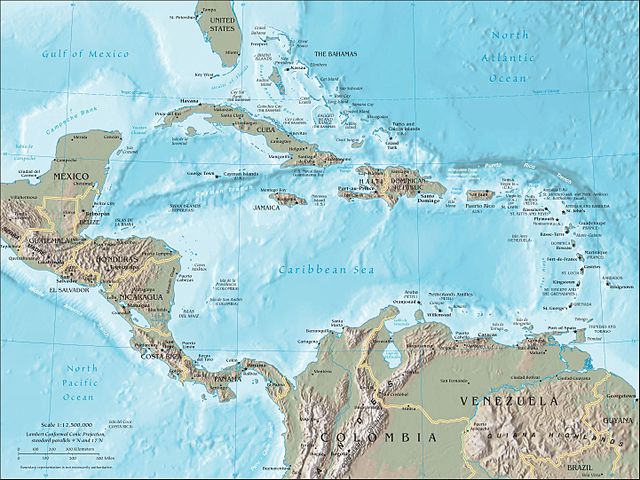
Caribbean Sea (Source: Wikipedia)
Bravado seemed to be a trait these pirate hunters and Spanish privateers had in common. In 1670, Captain Manuel Rivero Pardal, of the frigate San Pedro y La Fama, wrote the following letter to the commander of the Jamaican privateers.
I am he who this year have done that which follows. I went on shore at the Caimanos, and burnt 20 houses, and fought with Captain Ary, and took from him a catch [ketch] laden with provisions and a canoe. And I am he who took Capt. Baines, and did carry the prize to Carthagena, and now am arrived to this coast, and burnt it. And I come to seek General Morgan, with two ships of 20 guns, and having seen this, I crave he would come out upon the coast to seek me, that he might see the valour of the Spaniards. And because I had no time I did not come to the mouth of Port Royal to speak by word of mouth in the name of my King, whom God preserve. (Little, Pirate, 184)
Juan Francisco de Güemes y Horcasitas, the governor of Cuba, was a great supporter of the guarda costa. Domino López de Avilés captained the Triunfo, one of the vessels Güemes y Horcasitas sponsored, which enabled the corsair and his men to capture ten British ships in 1737. |
|
| Back to top |
|
 |
Salty Dog

Sailing Master 
Posts: 10060 



191991 Gold -

|
 Posted: Sun Oct 01, 2017 3:33 pm Post subject: Posted: Sun Oct 01, 2017 3:33 pm Post subject: |
 |
|
Colonial governors also welcomed men of other countries to serve aboard Spanish privateers and in the guardas costas. These foreigners only had to convert to Catholicism, which they did, and then they used their knowledge of their former compatriots to defeat them. Dutchmen Jan Erasmus Reyning (John Erasmus) and Jelles de Lecat (Yellows) were two of many who served Spain. In consort with another renegade, Felipe Geraldino (Philip Fitzgerald of Ireland), and several guardas costas, they sailed to Campeche and seized forty some vessels belonging to the English and Dutch. In 1674, Geraldino sailed into Havana after taking a New England bark with a cargo of food, spirits, and currency. An English prisoner happened to be working on the harbor’s fortifications and witnessed what happened next.
[H]e had five English tied ready to hang, two at the main yardarms, two at the fore yardarms, and one at the mizzen peak, and when he came near El Morro Castle he caused them to be turned off, and they hanged till they were dead, and Fitzgerald and his company shot at them from the deck of the frigate. (Marley, 1:141-142)
England came to see Geraldino as the most-wanted man in the Caribbean and the Lords of Trade and Plantations ordered colonial officials “to bring in the head of Fitzgerald the Pirate from Havana” in October 1675. (Marley, 1:142) But he apparently managed to elude his pursuers, for he was never captured.
Tired of continual depredations against their ships and colonies, Spain’s governor in Cuba, José Fernández de Córdoba, authorized Juan de Alarcón (also called Juan de Larco) to attack Charles Town, New Providence in the Bahamas.2 He and his men first landed at Andros Island where they forced three members of a captured sloop to guide them into the English colony’s harbor in the wee hours of 19 January 1684. They waited until dawn to attack, surprising most residents, who were still abed, and killing those who were not. The majority of the Spanish force attacked the town, but others went after the anchored vessels in the harbor. Rather than fight, some citizens fled, including Governor Robert Lilburne. He later wrote:
Juan de Larco with two hundred and fifty Spaniards came down the harbor and landed . . . half a mile to east of Charlestown. Captain Clarke being out of doors near the waterside, some men in ambush shot him through the thigh and cut his arms with a cutlass, and then they marched away with all haste to the town, firing into some houses as they went. Meantime, the Spaniards boarded a pink in the harbor, and hearing the sound of their shot and seeing the flash, I ordered a great gun at my door to be fired, to give the alarm. But before it could be loaded, the Spaniards were firing into the house, and I slipped out of the back door into the garden. A volley whistled past my head and we fled to the woods behind the town, where several women and some men (but only one of them armed) were already come. Not knowing what had happened, we waited till evening. (Marley, 1:7)
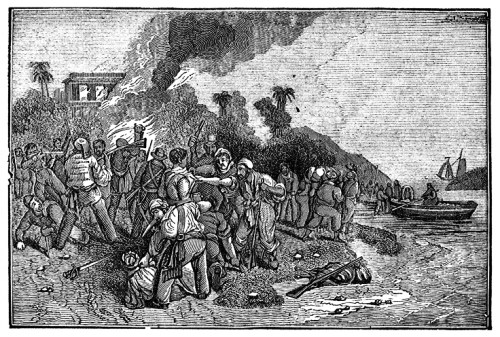
Pirates attack an island (Source: Dover Clip Art) |
|
| Back to top |
|
 |
Salty Dog

Sailing Master 
Posts: 10060 



191991 Gold -

|
 Posted: Sun Oct 01, 2017 3:35 pm Post subject: Posted: Sun Oct 01, 2017 3:35 pm Post subject: |
 |
|
Fourteen men mounted a defense that killed at least one Spaniard and wounded more. Two English vessels escaped, but four others were captured and three seamen were killed. The attackers stowed their plunder, which included £14,000 “in plate and money” in a captured vessel, and then sailed away. (Little, Buccaneer’s, 69) De Alarcón next attacked another English settlement on Elutera Island, only to return to New Providence and again attack Charles Town. These marauders “burnt all the houses, murdered the Governor and several more in cold blood, stripped the rest of the men naked, and carried away women, children, and Negroes to Havana.” (Marley, 1:
Part 2
Another commander in the guarda costa was Juan Corso. He liked to attack ships off the coast of Jamaica and take his prizes into Santiago de Cuba. As far as Governor Sir Thomas Lynch of Jamaica was concerned, Corso and the rest of his kind “. . . committed barbarous cruelties and injustices, and better cannot be expected, for they are . . . a mongrel parcel of thieves and rogues that rob and murder all that come into their power, without the least respect to humanity or common justice.” (Marley, 1:163-164) Lynch’s successor, Hender Molesworth, wrote:
These galleys and piraguas are manned by . . . rogues culled out for the villainies that they commit. They never hail a ship . . . . They lurk in the bushes by the shore, so that they can see every passing vessel without being seen. When our sloops are at anchor they set them by their compasses in the daytime, and steal on them by night with so little noise, that they are aboard before they are discovered. (Marley, 1:164)
Not only did Corso torture his captives into admitting that they traded illegally with Spanish colonies even if they hadn’t, but he also murdered them. One prisoner, taken from a French flibustier, was a deserter from René Robert Cavelier, Sieur de la Salle’s expedition to locate the mouth of the Mississippi River and establish a settlement there. On learning this piece of news, Corso set sail in 1685 to destroy the colony. Capitán Pedro de Castro joined the expedition. Their ship eventually wrecked at Punta Brava (in Florida), and many died. De Castro and thirty-five others survived, at least for a time, “by rendering the cut-up corpses in the stewpot . . . without wasting even the heads,” but only two were ever rescued. (Little, Buccaneer’s, 209)
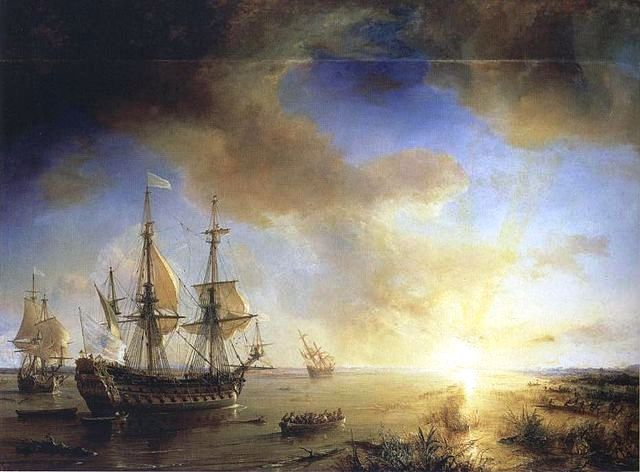
Theodore Gudin's La Salle's Expedition to Louisiana in 1684 (1844)
(Source: Wikipedia) |
|
| Back to top |
|
 |
Salty Dog

Sailing Master 
Posts: 10060 



191991 Gold -

|
 Posted: Sun Oct 01, 2017 3:35 pm Post subject: Posted: Sun Oct 01, 2017 3:35 pm Post subject: |
 |
|
During the War of the Spanish Succession, a third attack was launched against New Providence in September 1703, this time by Spanish corsair Blas Moreno Mondragón and French boucanier Claude de Lachasney. These two allies and their men forced an English captive to pilot them into Nassau’s harbor just before the sun rose. Their attacked surprised most residents, who had retired late after attending a gala to celebrate the birth of one gentleman’s son. Ellis Lightwood, the acting governor, reported that they
. . . found no resistance, nor was any of the inhabitants destroyed at that time, except only one man who was killed, and another had his hand cut off. However, before [the attackers] attempted the fort, they made a hail and by threatening their . . . prisoners, found that there would be no resistance, so proceeded and carried all before them. The French Captain and the Spaniards declared if anybody had appeared in the fort and fired but one gun, they would never have attempted it. (Marley, 2:713-714)
The tally of plundered loot “in gold, silver, slaves, etc.” came to £30,000. (Marley, 2:714) They also took eleven vessels and twenty-two of the fort’s cannons, while destroying the remaining eighteen, and demolished the gun carriages and gates of the fort. Before Mondragón and Lachasney departed two weeks later, they “burnt the town and church to ashes” (Marley, 2:714) and took with them eighty to 100 townspeople, including the governor. Four months later, in January 1704, Edward Birch arrived to take up his post as the new governor, and found roughly twenty people, who had survived the attack but lacked anything “to cover their nakedness.” (Marley, 2:714) Birch was so discouraged he sailed away several months later rather than govern the island. |
|
| Back to top |
|
 |
Salty Dog

Sailing Master 
Posts: 10060 



191991 Gold -

|
 Posted: Sun Oct 01, 2017 3:36 pm Post subject: Posted: Sun Oct 01, 2017 3:36 pm Post subject: |
 |
|

With the cessations of hostilities in 1713, Mondragón became a Captain in the Armada de Barlovento for having “dislodged the enemies from the island of Providence, which they had occupied, [and] having fitted out a brigantine at your own expense for this purpose and then continued patrolling the coasts of America, in pursuit of the pirates which infested them, to the detriment and loss which you experienced of said brigantine, fighting against them.”3 (Marley, 2:714)
Rather than join a guarda costa or become a privateer, some Spanish men preferred to go on the account. Most attacked other countries’ vessels, but others focused on Spain’s merchant ships. Diego Grillo, for example, was nicknamed “El Mulato” because of his African and Spanish ancestry. He began life as a slave in Havana, Cuba, but escaped and joined the buccaneers. In January 1671, he captained a 10-gun vessel when Morgan sacked Panama. When the Jamaican governor offered a pardon to all pirates, Grillo refused and continued his attacks on Spanish vessels. Instead of delivering his captured booty to Port Royal, now he sold it in Tortuga. Three ships went hunting for him, but Grillo defeated them and then slaughtered anyone aboard who had been born in Spain. Taken in 1673, he was hanged.
In 1687, Blas Miguel and his lieutenant, Pasqual Onan, attacked Petit Goave (on Haiti) with a band of Spanish pirates consisting of “as many whites [and] mulattoes as Indians and blacks.” (Little, Buccaneer’s, 210) They took the fort, sacked the town, torched most of the houses, and slew the men. French accounts also reported that they assaulted and then killed the women. Instead of withdrawing immediately, Miguel led his men in raids in the surrounding countryside. This gave the remaining French enough time to mount an attack in which they captured sixty pirates, most of whom were either hanged or killed before standing trial. Miguel and Onan were interrogated and then tried by thirteen men. The day after witnessing the deaths of forty-two of their men, they were broken on the wheel and then decapitated. |
|
| Back to top |
|
 |
Salty Dog

Sailing Master 
Posts: 10060 



191991 Gold -

|
 Posted: Sun Oct 01, 2017 3:37 pm Post subject: Posted: Sun Oct 01, 2017 3:37 pm Post subject: |
 |
|
Based in San Augustín (in Florida), Captain Nicholas de Concepción and his band of 140 men favored the waters off Virginia and the Chesapeake Bay. In September 1720, their brigantine attacked Mary, a sloop from Philadelphia. Other vessels were quickly taken, including the Planter from Liverpool. The English recaptured the Planter, but the pirates fled. During a search of the vessel, the Englishmen found Concepción’s letter of marque. Dated after the war between England and Spain had ended, it proved to be a forgery.
Originally a pirate, Richard Noland became a Spanish corsario. Prior to April 1717, he served as “quartermaster of the late Sam Bellamy,” but severed ties with the pirate sometime before then. (Marley, 2:726) By September, he was Benjamin Hornigold’s agent in Nassau, where he recruited men to serve with the pirate captain and took care of Hornigold’s finances while he was out plundering. Yet the following summer, he was a Spanish privateer in command of a piragua, who told a captive named Richard Taylor
. . . that a new Governor was lately arrived at the Havana from Spain, with orders to destroy all the English settlements on the Bahama Islands: and that they had provided for that purpose, one ship of 50 guns and 700 men, another of 26 guns and 300 men, and three row galleys full of men . . . the Alcade of Baracoa or Trinidad would for 500 pieces-of-eight condemn any vessel he carried in, and showed him a large commission from the Alcade of Baracoa for what he did. (Marley, 2:726)
Taylor remained Noland’s prisoner for nineteen days, during which time he witnessed Noland and his men take “six women and several children, but not one of the men” from one island. (Marley, 2:727)
Another pirate was Juan Andres (Andresote), whose crew of runaway slaves and Native Americans plundered and murdered along the Venezuelan coast in 1731. When the attacks ceased in 1733, colonial authorities assumed he was dead. In reality, he simply moved to Curaçao and resumed his bloody assaults. |
|
| Back to top |
|
 |
Salty Dog

Sailing Master 
Posts: 10060 



191991 Gold -

|
 Posted: Sun Oct 01, 2017 3:38 pm Post subject: Posted: Sun Oct 01, 2017 3:38 pm Post subject: |
 |
|
Part 3
During the first three decades of the nineteenth century, many of Spain’s colonies in the New World sought independence from the motherland. This gave rise to both corsarios and pirates, and distinguishing between the two sometimes depended on who captured them. With her navy unable to defend her trade against these interlopers and revolutionists, Spanish authorities authorized privateers to do it for the government. But these privateers never achieved the same success as their insurgent counterparts. From 1810 to 1830, Spain’s corsarios took eighty-six prizes and plundered another nineteen. Some of Spain’s privateer captains skirted the limits of their licenses for personal gain. After Captain Peiro captured the Eliza in June 1823, he had his men smuggle the plunder ashore and deliver it to the owner of the privateer, Don Diego López. Charges were brought against them the following year, and the judge decided they had violated seven terms of their commission. Peiro was sentenced to die, but succumbed before the date of his execution. Since López was unable to pay recompense to Eliza’s owners, he was imprisoned.
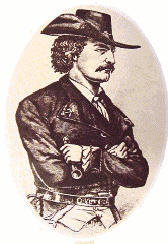
Revolutionary governments in Latin America also issued letters of marque, many to foreigners who wished to increase their purses and/or fight for the idea of freedom. In 1813, Cartagena became the first to authorize these commissions.4 Privateers in the Pacific held Chilean commissions, and Mexico authorized their own corsarios beginning in July 1815. Perhaps the best-known of these was Louis Michel Aury, whose squadron was based first on Galveston Island and later on Amelia Island after Jean Laffite moved his operations from Barataria to Galveston. Many of the vessels these privateers sailed were brigs and schooners, which carried an average of fourteen guns and 125 men. Between 1813 and 1829, according to Matthew McCarthy, these rebel privateers attacked 1,074 merchantmen.
How these privateers treated their victims depended on the captains. For example, in 1816, Charlotte fired on the Snapdragon. When the Cartagenan corsarios discovered their victim was neutral, they “expressed great sorrow for what they had done . . . and offered to make good the damage sustained.” (McCarthy, 29) On the other hand, John Nicholls of the Sophia “was much abused by the ruffian leader and after that most shockingly scolded with boiling water” after his vessel was taken by the privateer Popa. (McCarthy, 30) |
|
| Back to top |
|
 |
Salty Dog

Sailing Master 
Posts: 10060 



191991 Gold -

|
 Posted: Sun Oct 01, 2017 3:40 pm Post subject: Posted: Sun Oct 01, 2017 3:40 pm Post subject: |
 |
|
There was also an upsurge in piracy in the 1820s, and many rogues sailed from havens on the coast of Cuba. The violence they inflicted was often more brutal than in previous centuries – perhaps because governments no longer tolerated piracy and sent squadrons of navy ships to destroy them.
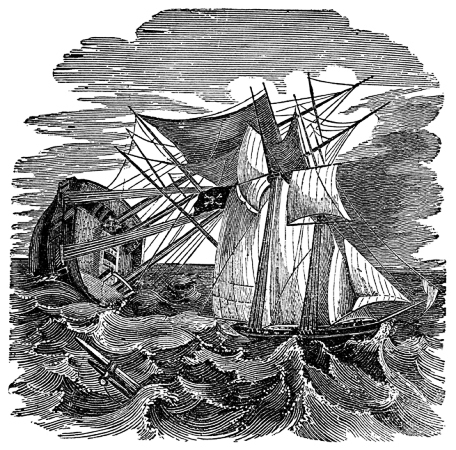
Late in 1824, the Betsey left Maine bound for Cuba. Rough seas drove the brig onto a rock, but the crew escaped in one of the boats and rowed for the Cuban coast. Fishermen provided them with shelter and eventually took them aboard a schooner, which soon crossed paths with a cutter “manned by TEN SPANIARDS, each armed with a blunderbuss, or musket, a machete, long knife, and pair of pistols.” (Collins, 19) Daniel Collins, one of only two men to survive the encounter, described them.
They were all dressed with neat jackets and trowsers, and wore palm-leaf hats. Their beards were very long, and appeared as though they had not been shaved for eight or nine months. . . . One of them had an extremely savage appearance, having received a blow, probably from a cutlass, across his face, that had knocked in all his front teeth and cut off a part of his upper lip . . . three of the fingers of his left hand, with a part of the little finger, were cut off, and the thumb was badly scarred. He was tall, well proportioned, and appeared to have some authority over the others. (Collins, 19-20)
In broken English the pirates made it clear what would happen to Collins and his comrades: “Americans were very good beef for their knives.” (Collins, 24)
They seized Captain Hilton by the hair – bent his head and shoulders over the gunwale, and I could distinctly hear them chopping the bone of the neck. They then wrung his neck, separated the head from the body by a slight draw of the sword, and let it drop into the water . . . The Captain’s dog, repulsed in his repeated attempts to rescue his master, sat whining beside his lifeless body . . . . (Collins, 25)
They slew three other captives with their knives, but the blow meant to kill Collins “divided the top of my hat, struck my head so severely as to stun me, and glanced off my left shoulder.” (Collins, 26) He leapt out of the boat and was hit by a thrown knife, but still managed to elude his pursuers. After the USS Ferret rescued him, they searched for these nameless pirates without success. He finally returned home in April 1825. |
|
| Back to top |
|
 |
Salty Dog

Sailing Master 
Posts: 10060 



191991 Gold -

|
 Posted: Sun Oct 01, 2017 3:41 pm Post subject: Posted: Sun Oct 01, 2017 3:41 pm Post subject: |
 |
|
Another seaman who wrote about his capture by Spanish pirates was Aaron Smith, who was first mate aboard the Jamaican Zephyr when the brigantine was taken in June 1822. In The Atrocities of the Pirates (1824), he described the pirate captain as a “man of most uncouth and savage appearance, about five feet six inches in height, stout in proportion, with large full eyes. His complexion was sallow and his hair black and he appeared to be about two and thirty years of age. In his appearance he very much resembled an Indian, and I was afterwards informed that his father was a Spaniard and his mother a Yucatan squaw.” (Captured, 22) This man had a particular dislike of American seamen, vowing “he would kill all belonging to that nation in revenge for the injuries that he had sustained at their hands – one of his vessels having been lately taken and destroyed by them – adding at the same time that if he discovered that we concealed the fact from him, he would punish us equally.” (Captured, 23)
Smith also recalled an incident that proved the coastal villagers protected these pirates. They had anchored near a Cuban village and were approached by canoes from shore. When the pirate captain showed no fear of the local magistrates, Smith asked why.
He laughed, and said I did not know the Spanish character. “Presents of coffee and other little things,” he said, “will always ensure their friendship. And from them I receive intelligence of all that occurs at the Havana and know every hostile measure [with] time enough to guard against it.” (Captured, 2
The violence this captain showed toward his victims was no less violent than what he visited on members of his crew whom he thought had betrayed him.
They paid no attention to his assertions [of innocence], but by the order of the captain, the man was put into the boat, pinioned, and lashed in the stern; and five of the crew were directed to arm themselves with pistols and muskets and to go in her. The captain then ordered me to go with them, savagely remarking that I should now see how he punished such rascals, and giving directions to the boat’s crew to row for three hours backwards and forwards through a narrow creek formed by a desert island and the island of Cuba. “I will see,” cried he, exultingly, “whether the mosquitoes and the sand-flies will not make him confess.”
Prior to our leaving the schooner, the thermometer was above ninety degrees in the shade and the poor wretch was now exposed naked to the full heat of the sun. . . . We had scarcely been half an hour in this place when the miserable victim was distracted with pain. His body began to swell and he appeared one complete blister from head to foot. . . . In a very short time, from the effects of the solar heat and the stings of the mosquitoes and sand-flies, his face had become so swollen that not a feature was distinguishable. (Captured, 33) |
|
| Back to top |
|
 |
Salty Dog

Sailing Master 
Posts: 10060 



191991 Gold -

|
 Posted: Sun Oct 01, 2017 3:41 pm Post subject: Posted: Sun Oct 01, 2017 3:41 pm Post subject: |
 |
|
Several months before Aaron Smith was captured, Spanish pirates also seized the Eliza Ann off the coast of Cuba. This time a woman was aboard, and Lucretia Parker later sent a letter to her brother describing what she experienced. When the pirates came aboard, “they commenced their barbarous work by unmercifully beating and maiming all on board except myself.” (Captured, 246) The pirate captain allowed her to leave the deck rather than witness such cruelty and he permitted her to do so. Although she assumed the men were murdered, she later found this was not the case. Nor was she spared a second time from the pirates’ cruelties.
The poor devoted victims, although alive, exhibited shocking proofs of the barbarity with which they had been treated . . . their bodies exhibiting deep wounds and bruises too horrible for me to describe! Yet . . . their lives had been spared only to endure still greater torments. Being strongly pinioned, they were forced into a mall leaky boat and rowed ashore . . . .
Having first divested them of every article of clothing but the shirts and trousers, with swords, knives, axes, etc. they fell on the unfortunate crew of the Eliza Ann with the ferocity of cannibals! . . . Having received a heavy blow from one with an ax, [Captain Charles Smith] snapped the cords with which he was bound, and attempted an escape by flight, but was met by another of the ruffians, who plunged a knife or dirk into his heart! I stood near him at this moment and was covered with his blood. On receiving the fatal wound, he gave a single groan and fell lifeless at my feet! (Captured, 247-248)
After her release, the Cuban government insisted Parker testify against the captured pirates. Seven were to be executed immediately. One was the captain; rather than allow his enemies to kill him, he stabbed himself with a knife he had concealed in his clothing. The suicide attempt failed, and he joined his men on the trip to the place of execution. A priest accompanied them to offer absolution, but the pirate captain “seemed deaf to all admonition or exhortation and appeared insensible to the hope of happiness or feat of torment in a future state. And so far from exhibiting a single symptom of penitence, declaring that he knew of but one thing for which he had cause to reproach himself, which was in sparing life and not ordering me to be butchered as the others had been!” (Captured, 257) |
|
| Back to top |
|
 |
Salty Dog

Sailing Master 
Posts: 10060 



191991 Gold -

|
 Posted: Sun Oct 01, 2017 3:43 pm Post subject: Posted: Sun Oct 01, 2017 3:43 pm Post subject: |
 |
|

Puerto Rico, still a Spanish colony during the nineteenth century, experienced economic hardships in 1818, giving rise to the most feared pirate of the Caribbean. Roberto Cofresí was born in Cabo Rojo in 1791. From a young age he wanted to be a sailor and eventually purchased a small boat, which he called El Mosquito. Many islanders saw him as a seafaring Robin Hood, but his victims found him malicious and cruel. Initially, he attacked only ships of other nations, particularly those of the United States. But Spain’s unfair treatment of his countrymen eventually led him to target Spanish ships too.
He often eluded his pursuers because coastal villagers signaled to warn him of approaching danger. Eventually, a coordinated force of Spanish and American naval vessels set out to capture him. An officer of the USS Grampus wrote:
. . . in March 1825, information was obtained . . . that Cofrecinas, a pirate of celebrity, was off Porto Rico . . . . After cruising in vain for several days . . . Cofrecinas’ piratical vessel was discovered in an obscure harbor called ‘Boca de Inferno’ (Mouth of Hell). He first ran for the sloop . . . but when within pistol shot to windward, the signal was given, and the seamen and marines, springing from below, fired a broadside into the astonished pirate, which cleared his deck for a moment of all but the undaunted Cofrecinas, who was at the helm. His men . . . kept up a running fight for more than an hour, displaying great skill in endeavoring to out-maneuver the sloop and escape. But after losing several of his men, he was forced to run his vessel ashore; the survivors jumped overboard, and waded through the water amidst the grape and musketry of the sloop, which killed several. (Life, 25-26) |
|
| Back to top |
|
 |
Salty Dog

Sailing Master 
Posts: 10060 



191991 Gold -

|
 Posted: Sun Oct 01, 2017 3:45 pm Post subject: Posted: Sun Oct 01, 2017 3:45 pm Post subject: |
 |
|
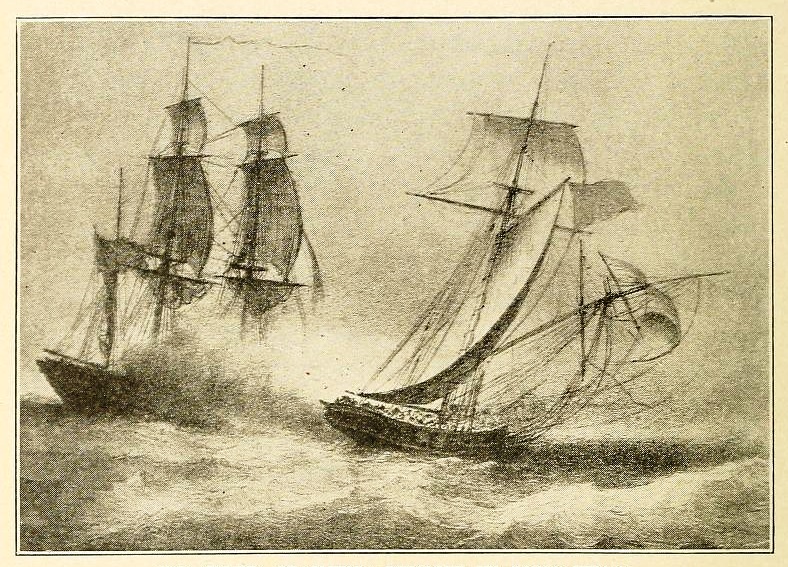
Sketch of the capture of El Mosquito from Historia de Puerto Rico by Paul Gerard Miller
(Source: Wikipedia)
Soldiers ashore captured him; he was imprisoned in San Felipe del Morro and tried by a Spanish court. Cofresí and eleven of his men were killed by firing squad on 29 March 1825. A witness to the execution reported that when offered a blindfold, Cofresí said, “I have killed hundreds with my own hands, and I know how to die. Fire!” (Life, 26)
Nicholas Fernandez led a far different life than the one his pious parents expected. He was born in Spain, but his parents moved the family to Cuba when he was a young boy. Although educated and from a family that possessed sufficient wealth to set him up in business, he preferred to see the world. Drink and gambling, as well as unscrupulous associates, robbed him of his money. He eventually fell in with a ruthless band of pirates led by Benito de Soto of Galicia, Spain in 1824. They became known for their brutality.
[A]s soon as we got a ship’s crew in our power, a short consultation was held, and if it was the opinion of a majority that it would be better to take life than to spare it, a single nod or wink from our captain was sufficient – regardless of age or sex, all entreaties for mercy were then made in vain – we possessed not the tender feelings to be operated upon by the shrieks and expiring groans of the devoted victims! – there was rather a strife among us, who, with his own hands, should dispatch the greatest number, and in the shortest period of time. (Dying, 10)
On 1 February 1826, their adherence to the adage of “dead men can tell no tales” was particularly brutal. A Portuguese ship with forty passengers, including several women and children, crossed their path.
[S]uspecting our character, and if overpowered by us, expecting no mercy, they bravely defended themselves, and twice with no other weapons than their knives, drove us from their decks, nor were they finally overpowered until they had killed three of our men, and severely wounded six more – our chief, as well as most on board, exasperated at the loss . . . breathed nothing but revenge, and would not . . . be satisfied with any thing short of the total destruction of the lives of all on board, without respect to sex or age! – a few light and most valuable articles found on board were thrown into our boats, and the ship then set on fire in three or four different places in her hold and cabin; and not until the flames had so increased that it was judged impossible for the wretched victims left on board to extinguish it, had we permission to quit the ship – the fire in columns bursting from every port, and communicating to the sails and rigging, soon drove the poor sufferers forward even to the extreme end of the ship’s bowsprit – where, with up-lifted hands they most earnestly intreated us to spare their lives! as we had destroyed the ship’s boats, all retreat was cut off, except to plunge themselves into the sea, which many did, but with no other effect than to prolong their misery for a few moments, for death was the portion of all who approached the schooner – some were shot in the water and others killed with hatchets while attempting to gain our decks! – the shrieks and dying groans of the unhappy victims on board the burning ship, as the devouring flames approached them, were calculated to pierce the hearts of any but barbarians like ourselves, destitute of every humane feeling – in less than one hour the shrieks of the dying had ceased! – . . . and little more was visible of the late noble ship but her bottom, burnt to the water’s edge! (Dying, 11-12) |
|
| Back to top |
|
 |
Salty Dog

Sailing Master 
Posts: 10060 



191991 Gold -

|
 Posted: Sun Oct 01, 2017 3:46 pm Post subject: Posted: Sun Oct 01, 2017 3:46 pm Post subject: |
 |
|
The memory of what he saw and did haunted Fernandez, and in his 1829 confession he said, “I could not but view myself as one who merited death by an equal degree of torture . . . . It was then that I from my very heart, cursed the unfortunate moment that I united myself with a band of cruel [and] unrelenting murderers! . . . it was but momentary, for by the aid of liquor I was soon enabled to drive all such harrowing reflections from my mind, and to unite with my companions in wickedly mimicking the agonizing distortions of the unfortunate Portuguese . . . .” (Dying, 12)
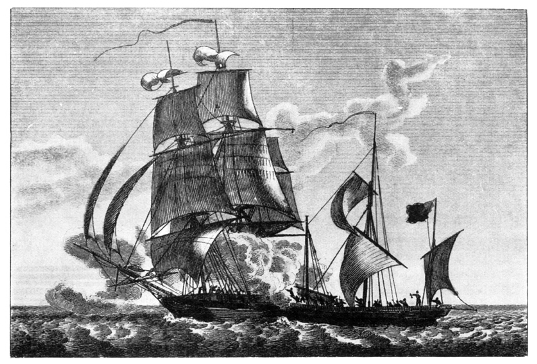
Their encounter with the Morning Star off the coast of Ascension Island on 19 February 1828, ultimately led to the deaths of eleven pirates, including Fernandez and de Soto. After a thorough plundering of the ship, the boarding party searched everywhere and took anything of value. The pirates ordered the male passengers to strip and locked the women in the round-house. Morning Star’s steward was forced to serve the pirates wine and food. When asked where his captain hid his money, the steward replied he didn’t know. Someone fired a pistol at his chest, but it misfired. Another attempt to kill him was made, but the leader of the boarding party thwarted that attempt. Then the pirates turned their attentions on the ladies. When they finished, the women were again locked in a cabin, the ship’s hatches were sealed shut, holes were bored in her hull below the waterline, and the Morning Star was set afire. After toppling the masts and destroying the rigging, the pirates left without making certain the flames consumed the ship.
Sometime after their departure, one woman “ventured to rise.” With the help of another woman they released the men. “The few sailors who were left repaired the main and mizzen rigging, whilst the ablest of the invalid soldiers, reduced to about eight, pumped the water out of the vessel.” (Narrative, 2
With the assistance from another ship, Morning Star eventually reached London on 18 April. Some of the pirates were later captured, tried, and found guilty. Fernandez and nine others were executed in Cadiz, Spain on 29 December 1829, while de Soto died a month later. The day before his execution, Fernandez decided his sentence was “consistent with the laws of God, and for the wellfare and safety of mankind, that we should be made a public example of – for, having shewn neither mercy or compassion to our fellow-creatures, we have none to expect from the hand of man!” (Dying, 19) The method of his execution was “to be hung, quartered and [his] head to be placed on hooks on the sea shore.” (Dying, 21) |
|
| Back to top |
|
 |
|
|
You cannot post new topics in this forum
You cannot reply to topics in this forum
You cannot edit your posts in this forum
You cannot delete your posts in this forum
You cannot vote in polls in this forum
|
Powered by phpBB © 2001, 2005 phpBB Group |
|















